How I used Google Glass: the future, but with monthly updates (part 1)

The doors of frosted glass on the 11th floor of the New York headquarters of Google swing open and I was greeted by a woman. There is nothing unusual about it. Slim, of medium height, bright inquisitive eyes. She bends down to shake my hand, and I suddenly pay attention to a strange device that looks like glasses: a thin strip of aluminum and plastic with a strange prism-like lens. Google Glass.
The fact that a few years ago seemed like eccentricity, then turned into something more than an experiment, and now it is starting to look like a real product. On something that can fall into the hands (or rather, on the heads) of consumers at the end of this year. The device is completely new kind, which can be worn without getting tired, created in order to take photos and communicate in a completely natural way. This is an anti-smartphone, specially designed to turn our understanding of interaction with mobile devices.
But as soon as I got rid of the handshake and studied the freaky device, I had only one question in my head: who would want to wear this in public?
')
Creating Points

The Glass project was launched “about three years ago” by an engineer named Babak Parviz as part of the X Lab project - a laboratory responsible, among other things, for creating a car without a driver and neural networks. Unlike these epic sci-fi designs, Glass came to life much earlier than everyone expected. At last year’s Google I / O conference, the company provided developers with an opportunity to participate in a device early testing program called the Explorer Program, and just a few weeks ago this program was expanded to give potential users in the US the opportunity to tell how they wanted to use this device. Something like an aggressive beta test, so typical of Google.
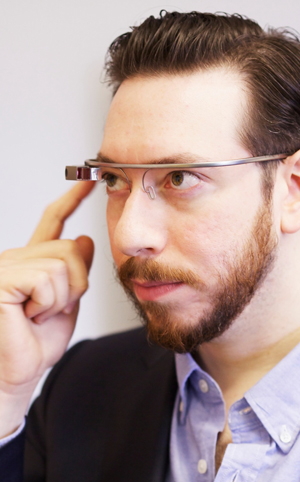
I myself was already close to the beta test points. But first, I had questions.
I sat in a surprisingly inconspicuous, by Google standards, room, opposite the two most important people in the Glass project — product director Steve Lee and chief designer Isabel Olson. Who, no matter how these people can talk about their offspring in all its glory. He is excited and cheerful, with large bright eyes, in which a sparkle is ignited every time he explains something about Glasses. Isabelle is more restrained, but with incredible fervor talks about the product. She also has very red hair. Before the start of the conversation, we ardently argued with her about what kind of color is called “navy blue”. She is in love with design - this love seems to be highly contagious in Google, and it shows.
Although I am primarily interested in the question of design, in the course of the conversation, I begin to understand why Points exist at all, certainly not to just become a fashionable fay. Steve is trying to explain it to me.
“Why do we even work at Points? We all know that people love to stay in touch. Relatives constantly send each other sms, fans check the score of their favorite team. If you travel often, you need to be aware of current information about your departure. Technique allows you to do it. But the problem is that we are constantly distracted by it. Suppose you are a parent and you need to photograph the performance of your children, their game of football or music. Or your friends will hold a camera to capture the moment. And guess what? He left. You just missed the awesome game. ” Isabel intervenes: “You saw Louis CK (joke), joking his parents:“ Your children are in reality in higher resolution ”? ". Everyone laughed, but that's the way it is.
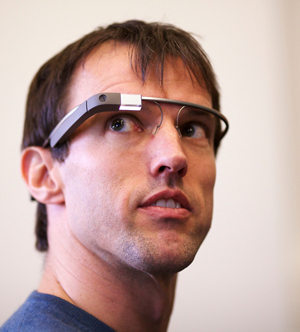
People themselves created a new problem for themselves after the iPhone was released and the subsequent mobile revolution: no one pays attention to what he actually does. Everything seems to be constantly looking down somewhere. These amazing moments, when your favorite band plays, or when your child reads poetry, is taken off with the lens of a device that is between you and reality or interrupted by incessant notifications. Signals from the outside world constantly interfere, no more, no less, your personal life.
Steve continues. “We thought that if we put the technique closer to the senses? Will it allow to receive information faster and communicate with other people, but in a way that does not disturb you if you do not use it? This is what brought us to the idea of Points. ” I can't stop looking at the lens near his eye. “This is a new wearable device. A very ambitious way to solve this problem, but this is really the reason why we are working on Glasses. ”
I understood. We are all constantly distracted. No one pays attention. We miss all the fun. Of course, this is a problem, but this is a new problem, and this is not the first time that we are distracted by technology. Hell, we used to think that because of the radio, cars would fly into a ditch. So can we still cope with what distracts us?
Maybe, but obviously, the Glass team is not going to wait for an answer to this question. Isabel tells me how she was fascinated by this concept. “Once I went to work - I live in San Francisco, and I work in Mountain View and the bus goes there; I went to the bus stop and saw how a line of 10-15 people were standing like this, ”she tilted her head and pretended that she had buried herself in a smartphone. “I don't want to do this, you see? I don't want to be that kind of person. And then it dawned on me: OK, we need to master this work. It is bold. This is crazy. But we can make something really cool about it. ”
Indeed, it sounds bold and crazy, especially after Steve announced that the company is going to release the end device at the end of this year .

Google level design

Forget about ordinary glasses for a moment. Forget about hipster glasses. Forget about John Lennon's round glasses. Forget “The Boys of Summer” (once popular song of Eagles singer Don Henley. It has this line - “You got your hair combed back and your sunglasses on, baby” - a comment of the translator); Forget how she looked with her hair and weifarers licked back (Wayfarers is a very fashionable model of glasses in the 80s - translator's note). Pretend these things don't exist. Just for fun.
Eyeglass design is really beautiful. Elegant, sophisticated. They look earthy and a bit alien. Futuristic, but modern - as if an artifact from the 60s, invented by someone who tried to imagine what would happen in 2013. This is an Apple level design. No, in a way, it even surpasses everything that Apple has done up to now. He is brave, resourceful, playful, but at the same time extremely simple. Materials are pleasantly felt in the hand and on the head, hard, but surprisingly light. Comfortable. If Google continues in the same vein, we will soon say something like “this is a Google level design”.
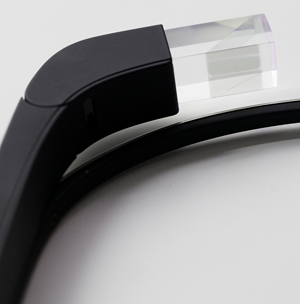
Even the layout fit wisely.
The whole system consists of only a few parts. The main body is made of soft-touch plastic and contains the "brain", battery and counterweight (which is located near your ear). There is also a thin strip of metal that forms an arc of glasses, with the usual bows and nose pads that allow the device to sit comfortably on your face.
Google introduced the first version of this device in several colors. If you do not show off, then it is: gray, orange, black, white and blue. I am joking with Steve and Isabel on how more creatively these colors will be called. “Gray is graphite? Wait, do not speak. I guess. I went through the list. "Tomato? Onyx? Dust, though not - Avalanche and Sea Breeze. " Steve and Isabel are laughing. “Not bad,” Isabelle said.
In fact: Shale, Mandarin, Coal, Cotton, Heavenly. I was close.
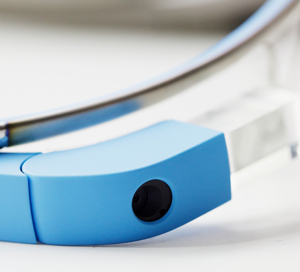
This conversation translates into a discussion on how important the color of the product you wear daily. “This is one of those things that you think about: 'oh, no matter what, it doesn't matter',” but it’s not. We began to realize how people become attached to their device ... Largely because of its color, "says Isabel.
But this is something. When I saw glasses in different colors, and then tried on tangerine and heavenly, I began to more emotionally relate to those that are more “mine”. This is not how you feel about a pair of your favorite glasses, but causes similar feelings. They should be felt exactly like yours.
Isabelle came to the project and Google from the design studio Yves Behar (Yves Behar's design studio). She joined the Glass team when their product was a pair of marvelous white-rimmed glasses with comically large boards glued on both sides. She shows me the Chanel box with the original prototype inside, its prism-like lens dangles limply near the right eye, the gray plume is stretched from one side to the other. Experimental version.
Isabelle's job was to turn the Glasses into something that can be worn, even if you are not sure that you want to wear them. She understands that there are still problems with this.
The version of Explorer, which Google will send, has a replaceable solar glass, which can be easily removed and put on, and worth noting, with this glass Points look more familiar. I also learned that the device can be easily disassembled by disconnecting the frame from the “brains” and the lens on the right. The point is that you can attach another frame that fits the Glasses, which will completely change their appearance, while retaining all the same functionality. Steve and Isabelle do not disclose whether they work with brands like Ray Ban or Tom Ford (I wear glasses from this company), but the New York Times recently wrote that Google is in talks with Warby Parker (the glasses manufacturer selling exclusively via the Internet - translator), and I believe that. Obviously, the company understands that you need to make this thing not just wearable - you need people to want to wear it. For me, glasses look beautiful, but somehow I still don’t want to wear them.
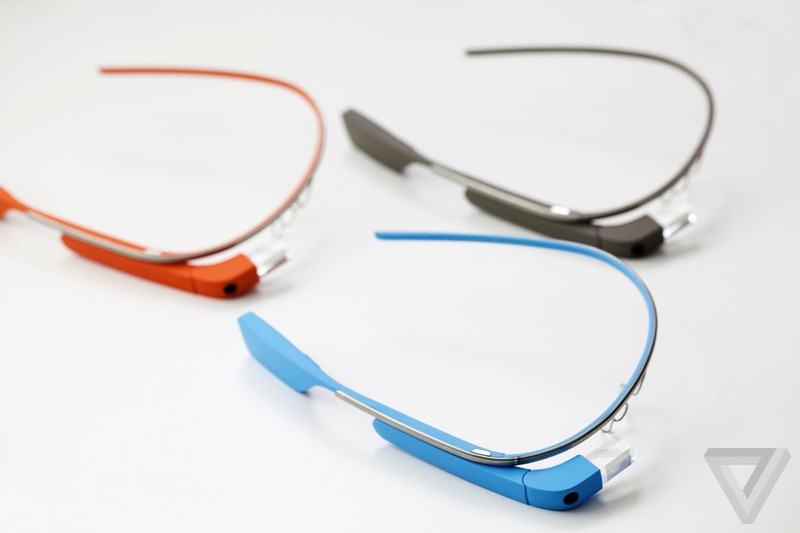
Continuation
Source: https://habr.com/ru/post/172479/
All Articles